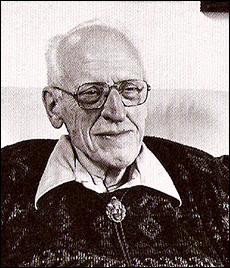Santa Fe Living Treasures – Elder Stories
<<Back to Treasures Index
Willard F.
|
Willard F. Clark"I've been a painter ever since I can remember," said ark. "The engravings came about because I needed for my print shop. I needed to make some money. Born in 1910 to Willard and Lena Clark in Somerville, Massachusetts, Willard spent his childhood in Buenos Aires. His father was president of General Motors of Argentina. When twelve year old Willard was sent from Argentina to school in the US, he began his formal training in art at the Central School in New York City. Willard was nineteen, and on his way to California in 1928, topped in Santa Fe to visit friends. Willard, who spoke Spanish fluently, fell in love with the people, the culture, and the land, which reminded him of Argentina. He met Bertha Berchtol at a country club dance and married her in 1930. Together they built a home and established a print shop on Sosoya Lane in 1931. "The house was built by me because I didn't have any money, and it was the only way knew to get a house," Willard said. "It started out as a place to work, and then I turned it into a place to live." The Clarks raised two daughters, Doris and Bertha.
Willard's expertise as a printer and his congeniality were praised by others. "My print shop was my living," Willard said There he did "all types of printing," including the Newman typeface Willard used, which has come to be associated with Santa Fe. He printed "thousands of letterheads, office forms--everything a printer has to do," he said. "I wanted to use my art to embellish my printing." Willard learned to make woodcuts and engravings so he wouldn't have to wait ten days for zinc etchings to be sent to Denver. "Nobody in those days waited ten days for a print job. You got the job in the afternoon, you delivered the next day. That's the way it was." . Willard went to work in Los Alamos in 1943. "I was a machinist, a tool and die maker. After the war stopped, I was planning on coming home and reopening my print shop, but it seemed to me at the time that the family would be better off if I stayed with what I was doing." He retired from Los Alamos National Laboratory in the mid-1970s. Please see Volume 1 for complete text. |
